 |
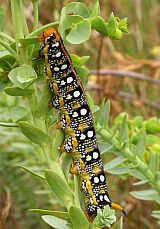 Spurge Hawkmoth larva
Spurge Hawkmoth larva
Hyles euphorbiae
© Teresa Farino
Butterflies and Moths of the Picos de
Europa - 2006 trip report
by Teresa Farino
25 June - 1 July 2006
Six members of Butterfly Conservation joined Teresa for another interesting series
of butterfly and moth forays in June 2006, based in the Picos de Europa but with side
trips into the nearby Castilian plains, during which we recorded 93 species of butterfly
and some 140 moths (both day flying and in the moth trap). Once again we deal with the
families in taxonomic order.
Butterflies
Just 10 species of Hesperiidae (Skippers) were recorded, including good numbers of
Lulworth Skippers, plus the distinctive Marbled Skipper, more abundant this year
than is the norm, and other non-British species such as Mallow Skipper, Red-underwing
 Swallowtail
Swallowtail
Papilio machaon
© Teresa Farino
Skipper, and the very similar Large Grizzled and Oberthür's Grizzled Skippers. In
the Papilionidae, we had several sightings of all three Picos species: Apollo,
Swallowtail and Spanish Swallowtail. It's worth noting here that the recent
guide by Lafranchis considers our subspecies feisthamelii of Spanish Swallowtail
to be a separate species, which he calls Spanish Swallowtail. Eleven species of
Pieridae were also recorded, with Clouded Yellow in extraordinary numbers in all habitats,
Mountain Clouded Yellow only seen above Fuente Dé at around 2,000 metres, and Bath White
rather commoner than usual this year.
We recorded 25 species in the Lycaenidae, including four hairstreaks and five coppers.
These jewel-like little butterflies were everywhere abundant, with Long-tailed and
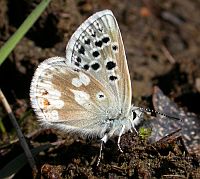 Gavarnie Blue
Gavarnie Blue
Agriades pyrenaicus asturiensis
© Teresa Farino
Silver-studded Blues very common in 2006, while the Gavarnie Blues at the top of the
cable car were very obliging for the photographers. As this trip took place earlier
than last year's, only one individual of Dusky Large Blue was found at the site we
discovered last year (see 2005 trip report),
but we also came across a single male Baton Blue - a species which we have not seen in the
Picos for almost a decade - in the Mediterranean habitat near Porcieda.
Notable among the Nymphalidae (24 species) were Marsh Fritillary, Purple Emperor - one
 Cardinal
Cardinal
Argynnis pandora
© Teresa Farino
extremely obliging individual was very taken with Teresa's sandal! - and Southern White Admiral,
with every habitat rich in fritillaries. Cardinals were extraordinarily common this summer,
as were Queen of Spain and High Brown Fritillaries. Twin-spot Fritillary was once again only
seen on the Castilian Plains, but unfortunately we were just too late for Bog Fritillary.
We also recorded 18 species in the Satyridae, although we were a little early for the main
emergence of this high-summer family. Worryingly, none of the ringlets at the top of the
cable car was Lefèbvre's, possibly as a result of the late snows followed by a prolonged
dry period, but by contrast, Chapman's Ringlet - the largest of the genus Erebia - was unusually
common this year, flying well into mid-July. We were also delighted to find both male and
female Large Ringlets at Piedrasluengas, and several Great Banded Graylings during the course
of the week.
Moths
We set out the moth trap (a Robinson trap powered by an 80W Mercury Vapour Lamp) on the
terrace of Teresa's house on five occasions (we were rained off on the other nights),
recording a good range of macromoths over the course of the week, although as there is
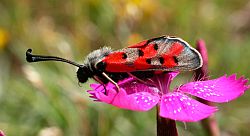 Zygaena rhadamanthus
© Teresa Farino
a distinct lack of identification guides for the micromoths in Spain, this group was
largely ignored,. We also recorded day-flying moths during our daily butterfly forays,
doing particularly well with the burnet moths (see below).
Zygaena rhadamanthus
© Teresa Farino
a distinct lack of identification guides for the micromoths in Spain, this group was
largely ignored,. We also recorded day-flying moths during our daily butterfly forays,
doing particularly well with the burnet moths (see below).
Once again, just two species of Cossidae - Goat and Leopard Moths - were observed, with
a fantastic Fiery Clearwing being the only representative of the Sesiidae seen. In the
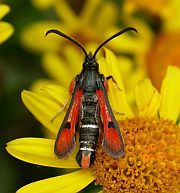 Fiery Clearwing
Fiery Clearwing
Pyropteron chrysidiformis
© Teresa Farino
Zygaenidae (10 species), we were rewarded by no less than eight species of Zygaena,
including Slender Scotch Burnet, very rare in the UK, as well as the particularly distinctive,
non-British Z. rhadamanthus and Z. lavandulae in the Castilian Plains. Just one species
of Thyatiridae came to the light - Figure of Eighty - and we identified 27 species of
Geometridae, although a number of others are awaiting identification by UK experts;
hopefully the publication of Geometridae Ibericae in 2007 will help to alleviate this
problem in the future. Among the rarer UK species to put in an appearance were Great
Oak Beauty, Jersey Emerald and Portland Ribbon Wave, and we also recorded the first ever
Gems for the Picos, both males and females.
Just one species of Lasiocampidae - The Lappet - was recorded, in contrast to seven species
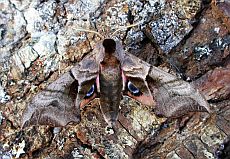 Eyed Hawkmoth
Eyed Hawkmoth
Smerinthus ocellatus
© Teresa Farino
of hawkmoth (Sphingidae), among which was another new species for the Picos: Eyed Hawkmoth. The diurnal Hummingbird Hawkmoth occurred in some
abundance and in most habitats, and we also saw one of the Beehawks - another day-flying species - although it was
moving so fast that we couldn't determine whether it was Narrow-bordered or Broad-bordered. We were also delighted
to locate some pretty-well full-grown larvae of Spurge Hawkmoth on the sand-dunes at Liencres, right at the start
of the tour (see top of page).
All six of our Notodontidae came to light; these were Buff-tip, Poplar Kitten, Iron, Pebble and Three-humped Prominents,
and the non-British Lesser Puss Moth (Cerura erminea), with the Pine Processionary being the sole representative of the
Thaumetopoeidae. Five species of Lymantriidae were recorded, again all in the trap, including Pale Tussock,
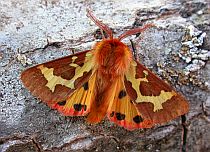 Spanish Tiger
Spanish Tiger
Hyphoraia dejeani
© Teresa Farino
Black Arches and Brown-tail, as well as Gypsy Rose (Ocneria rubea) and another addition to the Picos list: the Vapourer. Of the
Arctiidae we recorded 11 species, with Feathered Footman and Clouded Buff being the principal day-flying representatives,
although we also came across an individual of the normally nocturnal Spanish Tiger (Hyphoraia dejeani) at San Glorio.
As well as Rosy Footman, Dew Moth and Garden and Ruby Tigers, hundreds of both male and female Four-spotted Footmen came
to our light, not a few of which were observed copulating in the morning (not
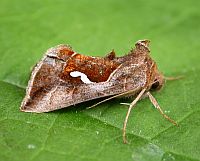 Dewick's Plusia
Dewick's Plusia
Macdunnoughia confusa
© Teresa Farino
a bad way of finding a mate!)
Around 60 species of Noctuidae was our total for the week, and although no new species put
in an appearance, we recorded many species which are rather scarce in the UK, including
Clay and Plumed Fan-foots (or should that be Fan-feet?), Oak Yellow Underwing,
Scarce Blackneck, Small Black Arches (often placed in a separate family: Nolidae),
Pale Shoulder, Eublemma purpurina (only recently added to the British list), The Ni Moth,
Dewick's Plusia, Bordered Straw, Scarce Bordered Straw, Orache Moth, The Latin,
Bordered Gothic, White-point, L-album Wainscot, The Cosmopolitan, Great Brocade
and Pearly Underwing. Also observed was the non-British species Catocala conversa,
which is rather like a very large Oak Yellow Underwing.
Important note: in Spain it is ILLEGAL to use a butterfly net or moth trap without a permit from
the relevant authorities, even if you do not take specimens.
Teresa Farino
Natural history tours in the Picos de Europa:
Butterflies and Moths of the Southern Valleys of the Picos de Europa
Natural History of the Picos de Europa and Páramos of Northern Castile
A Family Wildlife Holiday in the Picos de Europa
A Feast of Flowers - botanical trips to the Picos de Europa
Daily wildlife excursions in the Picos de Europa
Reports from past trips to the Picos de Europa:
Butterflies & moths of the Picos de Europa - 2008 trip report
Butterflies & moths of the Picos de Europa - 2006 trip report
Butterflies & moths of the Picos de Europa - 2005 trip report
A Feast of Flowers in the Picos de Europa - 2009 trip report
BSBI Botanical Tour of the Picos de Europa - 2004 trip report
Related information:
Picos de Europa - a naturalist's paradise
Complete list of butterflies for the Picos de Europa
Read about Teresa Farino
Wildlife holidays and natural history tours in Spain & Portugal
|